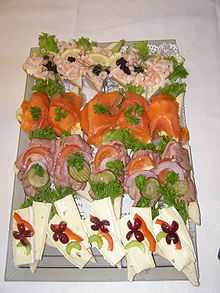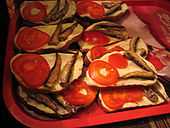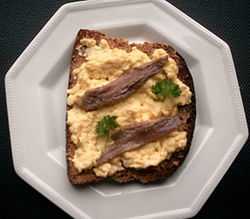Open sandwich
| Open sandwich | |
|---|---|
| Sandwich | |
 Smørbrød, smørrebrød or smörgås, Scandinavian open sandwich at a cafeteria in Norway | |
| Alternative name(s): | |
| Open face sandwich, open faced sandwich, Ulrich Sandwich, bread baser, tartine | |
| Main ingredient(s): | |
| Bread, topping | |
| Recipes at Wikibooks: | |
|
| |
| Media at Wikimedia Commons: | |
|
|
An open sandwich, also known as an open face/faced sandwich, Ulrich Sandwich, bread baser, or tartine, consists of a single slice of bread with one or more food items on top.
History
During the Middle Ages, thick slabs of coarse bread called "tranches" (late 15th century French) or, in its English derivative, "trenchers", were used as plates. At the end of the meal, the food-soaked trencher was eaten by the diner (from which we get the expression "trencherman"), or perhaps fed to a dog or saved for beggars. Trenchers were as much the harbingers of open-face sandwiches[1] as they were of disposable crockery.
As such, open-face sandwiches have a unique origin and history, differing from that of the true (multi-slice) sandwich.
In various countries
An open sandwich is a slice of fresh bread, with different spreads, butter, liver pâté, cheese spreads, cold cuts such as roast beef, turkey, ham, bacon, salami, beef tongue, mortadella, head cheese or sausages like beerwurst or kabanos, and vegetables like bell peppers, tomatoes, radish, scallion and cucumber. Open sandwiches like this are consumed in Austria, Germany, the Czech Republic, Hungary, the Netherlands, Poland as well as other parts of Europe, and North America as a regular breakfast and supper food item. The American tongue toast is offered as an entrée for breakfast, lunch, and supper and as an hors d'œuvre for formal parties.
In Great Britain, open sandwiches are rare outside of Scandinavian delicatessens. Instead, there is "on toast" (e.g., cheese on toast). However, this is not considered a sandwich.
The Dutch and Flemish Uitsmijter arrives on a large plate with large slices of usually white bread, topped with a selection of meats, cheeses, vegetables and possibly an egg. The dish is often served as a hearty breakfast.
Open sandwich is the common, traditional sandwich type in the Nordic countries, Estonia, the Netherlands, Russia, Poland, Lithuania, and Latvia, where it is typically eaten at breakfast, lunch, supper, or as a snack.
The Scandinavian open sandwich (Danish: smørrebrød, Norwegian: smørbrød, Swedish: smörgås) consists of one piece of buttered bread, often whole-grain rye bread (Danish: rugbrød, Swedish: rågbröd), topped with, for instance, cold steak, shrimps, smoked salmon, caviar, hard boiled eggs, bacon, herring, fish fillets, liver pâté (Danish: leverpostej, Norwegian: leverpostei Swedish: leverpastej), and/or small meatballs. This is typically complemented by some herbs and vegetables such as parsley, cold salad, thinly sliced cucumber, tomato wedges and/or pickled beets etc. on the same slice of bread. A condiment, such as mayonnaise, or mayonnaise-based dressing is also often included in some form. An old traditional replacement for butter on a piece of bread with herring is pig fat. There are many variations associated with the smørrebrød/smørbrød/smörgås and there are even special stores, cafés and restaurants (especially in Denmark) that specialize in them. In Finland the sandwich is called voileipä which also means "butter bread" and the Finnish rye bread is ruisleipä.
Sweet toppings are commonly used for breakfast in the Netherlands and Belgium: e.g. sprinkles, vlokken, or muisjes, next to the more widespread peanut butter, honey, jam, and chocolate spread.
In the United States an open faced sandwich may also refer to a slice of bread topped with warm slices of roasted meat and gravy (called a "Manhattan" in some areas), or bread topped with Welsh rarebit. This is also done in Scandinavian countries, where they eat open faced sandwiches with fried meat and fried fish quite often.
In former Czechoslovakia a popular type of open sandwich is called chlebíčky (pl., sg. chlebíček) - slant ways cut slice of veka (long narrow white bread) spread with butter and/or with various combinations of mayonnaise salads and hard boiled egg, cheese, ham, salami, smoked fish (salmon or sprats or pickled herring), tomato, pickled cucumber, lettuce, raw onion or other vegetable, etc.
Usage
The term "sandwich" is occasionally used (informally) in reference to open-faced sandwiches, but the term "sandwich" more formally refers to a dish with two slices of bread with a filling between them, not on top.[2] The open-faced "sandwich" also has a unique history (described above), originating between the 6th and 16th centuries, whereas the modern sandwich traces its roots to the Earl of Sandwich.[1]
In the court case in the United States of White City Shopping Ctr., LP v. PR Rests., LLC, 21 Mass. L. Rep. 565 (2006), the judge ruled that a true sandwich (from a legal perspective) must include at least two slices of bread.[3] Many open-faced sandwiches do not satisfy this condition, although some served in diners and restaurants in the northeastern U. S. actually do pile the meat and gravy atop two overlapping slices of bread.
Different kinds of open sandwiches
-

Smørbrød, Norwegian open sandwich
-

Open-faced tuna sandwich with guacamole sauce and cherry tomatoes
-

Russian buterbrod with tomatoes and sprat
-

Czech Jednohubky
-

Eggs Benedict, an open-faced sandwich consisting of an English muffin topped with meat, eggs, and hollandaise sauce.
-

Scandinavian räksmörgås (open faced shrimp sandwich) in Stockholm.
-

Scotch woodcock, scrambled eggs on toast garnished with anchovy fillets and parsley
-

Open sandwiches in Vienna, with a Pfiff-size beer
-
Small open sandwiches. Bread, butter and codfish liver paste.
-

A hot fish sandwich from Bolton's Spicy Chicken & Fish at the Franklin Food & Spirits Festival in Franklin, Tennessee
See also
References
- ↑ 1.0 1.1 What's Cooking America, Sandwiches, History of Sandwiches. February 2, 2007.
- ↑ http://www.askoxford.com/concise_oed/sandwich?view=uk
- ↑ Boston Globe, Arguments spread thick
External links
| Wikimedia Commons has media related to Open sandwich. |
.JPG)